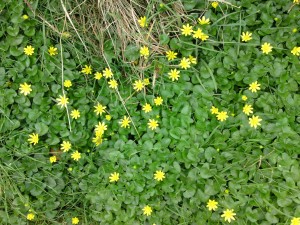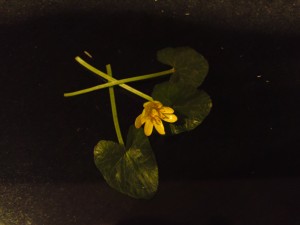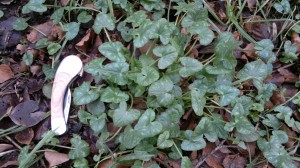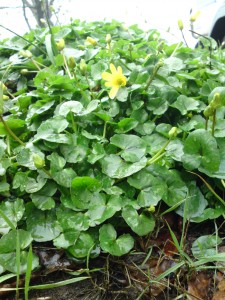Lesser celandine – Edibility, distribution, identification
Ranunculus ficaria
- Edibility – Leaves – 2/5, Root Bulbils – 3/5 – but see warnings below
- Identification – 3/5 – look for bright yellow flowers, individually stalked cordate veined leaves, often with paler patches, and (often) bulbils on roots. It is a low-growing plant, often forming substantial mats.
- Distribution – 5/5
- Season – January – May – One of the earliest spring leaves.
- Habitat – Damp deciduous woodlands, meadows, shady waste ground, hedge banks, roadsides, river banks and other areas that are seasonally flooded. Those pictured were growing adjacent to a large puddle in the road and were enjoying a good dousing by every passing car. As I drove further I noticed that all the larger bulges of it corresponded with puddles in the road.
Prior to flowering, lesser celandine is one of the milder spring leaves, so good for bulking out salads of more pungent leaves like hairy bitter-cress, ground elder, and ramsons.
As a member of the generally toxic buttercup family (ranunculaceae), lesser celandine contains small amounts of pyrrolizidine alkaloids (PA’s), a family of plant compounds produced as a defense mechanism against insect herbivores, but often also hepatoxic (causing liver damage) in humans. They are also associated with the increased incidence of some cancers.
Read my article on The Spectrum of Edibility
So lesser celandine should not be eaten in large quantities, and not at all by anyone with health issues. Boiling or steaming the leaves and stems or stir-frying like spinach/pak-choi diminishes the PA’s and makes for a decent enough green vegetable.
The bulbils (nodules) that appear on the roots give lesser celandine its old english name of Pilewort. This is in accordance with The Doctrine of Signatures, whereby if part of a plant looked like a part of the human body, it would be used to treat that part of the body. Although it may sounds quite far fetched when you first hear it, we are less surprised when our attention is drawn to examples of plants signalling their usefulness to other animals. So why should plants not have evolved alongside humans to manipulate – and help – us?
The bulbils are pleasantly crunchy and are best boiled or roasted and added to salads for crunch.
Lesser celandine is not recommended for eating once it has flowered (and it flowers really early in the year – around early March in SW Scotland) as it become higher in protoanemonin – a compound that can cause irritation in the mouth and gastrointestinal tract. The whole plant becomes increasingly bitter and not very pleasant to eat.
To be honest, I don’t much bother with lesser celandine as, beyond its slightly troublesome chemistry, its fiddly to pick and usually surrounded by lots of easier to harvest, tastier, more nutritious and less toxic plants!
Related Posts:




12 Comments
Its protanamonin isnt it?in all the buttercup family??i thort u cud only eat the leaves wen they were young??wen does it develop the toxins??very intrigued!! U covered horsetail??im curious about that too
Hi,
Yes, protoanemonin. More as they mature. There are lots of way better wild plants about at this time of year.
Sorry, I haven’t yet covered horsetail here.
Happy foraging,
Mark.
Hi
Can i ask if you eat the root of the celandine, i roast them and eat they are really tasty
thanks
Chris
Hi Chris,
Yes, I have in the past, but its not something I eat a lot of. But you given me new incentive to revisit it!
Cheers
Mark
Great info. My understanding of the epithet ‘pilewort’ is they were thought to treat piles (hemmorhoids); is this correct? In parts of the midwestern United States lesser celandine has become terribly invasive, displacing our native spring ephemerals, especially along streams and bottomlands. Here in southwest Ohio it’s becoming one of our worst invasives, alongside Amur honeysuckle, wild garlic mustard, and some others.
Yes – that’s correct. I’ve embellished my discussion of this in the text – thanks for the reminder! 🙂
When i was 6 or 7 years old inthe park low to ground was a plant we called sour leeks we loved them it was the stalk and leaf we ate. Would you know what it was?
Sounds like common sorrel, rumen acetosa, possibly. See also wood sorrel. 🙂
I’m suffering from Heameroids wanted a herbal remedy, wanted to check what pilwort looked like Lesser Celandine an invasive in my garden although beautiful plant . Don’t want surgery! More complications. Many thanks for an excellent site!
Hi horse chestnut seeds tincture or extract are excellent for haemorrhoid.
A lady told me her parents or someone she knew used to make celandine wine from the flowers? Have you ever heard of them being used this way?
Hi Angelique,
No, I haven’t heard of this before. I’m a bit surprised as the flowers seem fairly tasteless when i’ve nibbled them in the past. Perhaps its a quantity thing…?
Cheers
Mark.